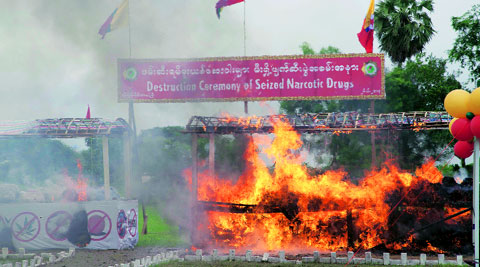
In Myanmar, source of the narcotic, a seized consignment of methamphetamine is set on fire.
Aizawl, Aug 29 : Raw material through state returns as methamphetamine from Myanmar.
The best quality of methamphetamine, a highly-addictive narcotic with no known medical treatment, has been trickling into India from Myanmar and caused panic in Mizoram, where large consignments are regularly being intercepted, the latest during the weekend of 20,000 pills worth Rs 70 lakh.
“We are facing an onslaught of a narcotic that is more harmful than any we have experienced so far… Methamphetamine is not to be taken lightly, and every family should prepare itself to counter it, every community-based organisation should make battling it a top priority,” the state’s excise and narcotics department (END) said in a public appeal issued last month. Local newspapers frequently carry opinion articles about the narcotic while the Young Mizo Association and church organisations have regularly held awareness campaigns.
The narcotic is not really new to Mizoram. The first seizures were made in the first two years of the last decade, with over 1,600 pills apprehended. For the next 10 years, however, meth disappeared from law-enforcement agencies’ radar. Since 2011, Mizoram has seen huge seizures of pseudoephedrine, a legal drug prescribed for colds and allergies, but which can be processed into methamphetamine. Close to 100 pseudoephedrine traffickers have been arrested and roughly 20 million tablets intercepted in three years by police, END officers, customs and even community-based organisations, but officials estimate just 10 to 20 per cent of all the consignments passing through Mizoram have been detected.
Most of it came from pharmaceutical companies in north and west India. Taken out of their strips and transported in gunny bags and polythene bags, they were being sent to Myanmar where, the UN Office on Drugs and Crime says, these apparently harmless drugs are processed into methamphetamine by cartels and ethnic armies that, until a few years ago, supplied the drug to the “Golden Triangle” of Southeast Asia and used the money to buy arms.
These drugs have recently begun returning west, and India’s eastern borders and Bangladesh seem the main corridor. In the last two years in Mizoram, police and END have seized more than 2.5 lakh methamphetamine tablets and arrested 20 traffickers, half of whom are Myanmar nationals, while a police inspector has been suspended and an inquiry instituted against him.
The pseudoephedrine racket, meanwhile, has also brought in the names of a former health minister, political leaders, government officials, and some police and law enforcement officials, with consignments found in parcels sent through India Post, trucks, cars and even suitcases of students flying home from Delhi and other metros.
High and low
Methamphetamine pills come in bright red, pink, green and orange coatings and are invariably stamped with the insignias of cartels in Myanmar. These include “WY” (a brand the UNODC considers the “most popular, of highest quality and the most expensive” meth pills from Myanmar), “88” and “R”.
A teenage user says he has been hooked to meth for a year-and-a-half; he was introduced to it at a Valentine’s Day party. “The high… I danced the entire night, then I went to another party and danced and danced,” he said. “There was a feeling of confidence, and my sexual appetite has increased but I have also developed a dysfunction, so that does not make any sense.”
He came in touch with dealers and now buys pills almost weekly. He has also tried methamphetamine “chewing gum”, tablets he inserts into the anus and a powdered form that he injects into his veins.
Each pill costs him Rs 250. He admits to stealing from his father’s debit card. He used to be a good student but is now struggling to finish XII. He has trouble sleeping — “just two to four hours, if at all”— and complains of severe body pains and restlessness, conditions that have forced him to seek treatment at a daytime drug addiction cessation unit for opiate addicts.
“Sometimes I keep chewing my pillow because the pain is difficult to bear,” he said. He has been prescribed a strip of 100 mg painkillers and seven sleeping tablets a day.
Treatment challenge
Dr Lalchhanhima Ralte admits treating a methamphetamine addict is a new challenge, one he and colleagues are ill-prepared for. Synod Hospital, where he works, has been treating drug addicts for decades through a specialised division that has also caught the attention of the UNODC, which plans to set up India’s first methamphetamine treatment centre there.
“There is no treatment for methamphetamine addiction. At most, we prescribe antidepressants. There is no substitute like in the case of opiates,” Dr Ralte admits.
There is no properly compiled data to ascertain how many methamphetamine addicts live in Mizoram. “They are all definitely younger than 25. Their symptoms are all the same, but there is little we can do. The problem is that these few who have come are just those who have already tried methamphetamine long enough to want to quit it. We have no idea how many are hooked to it but have not thought about quitting,” said Lalrinawma Chhakchhuak, project manager at the cessation units.
Estimates put the number of opiate and pharmaceutical drug abusers in Mizoram at about 20,000 while END records show that since 1984 at least 1,240 people have died due to overdose, mostly of opiates such as heroin.
“When heroin began to be detected in Mizoram in the early 1980s, everyone said it’s a western drug and for developed countries. That was proved completely wrong,” said Chhakchhuak. “The fear is that it is going to be the same story for methamphetamine.”







0 comments:
Post a Comment